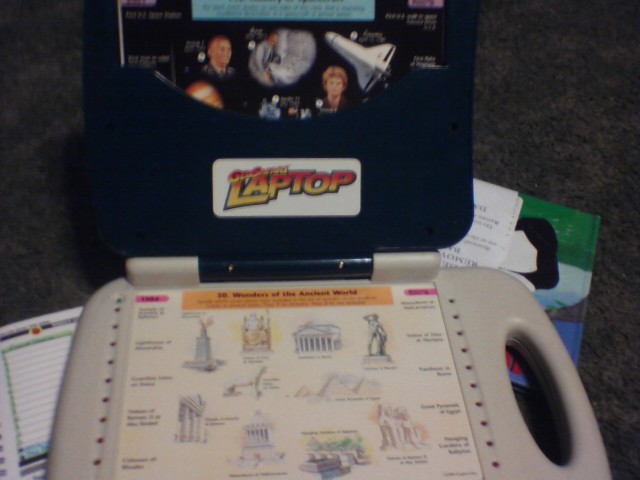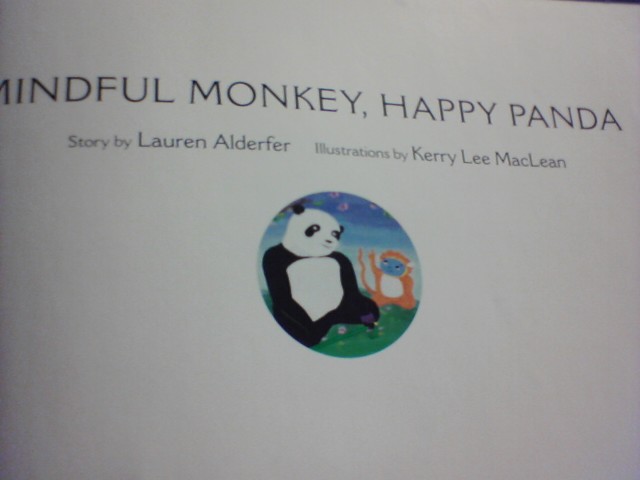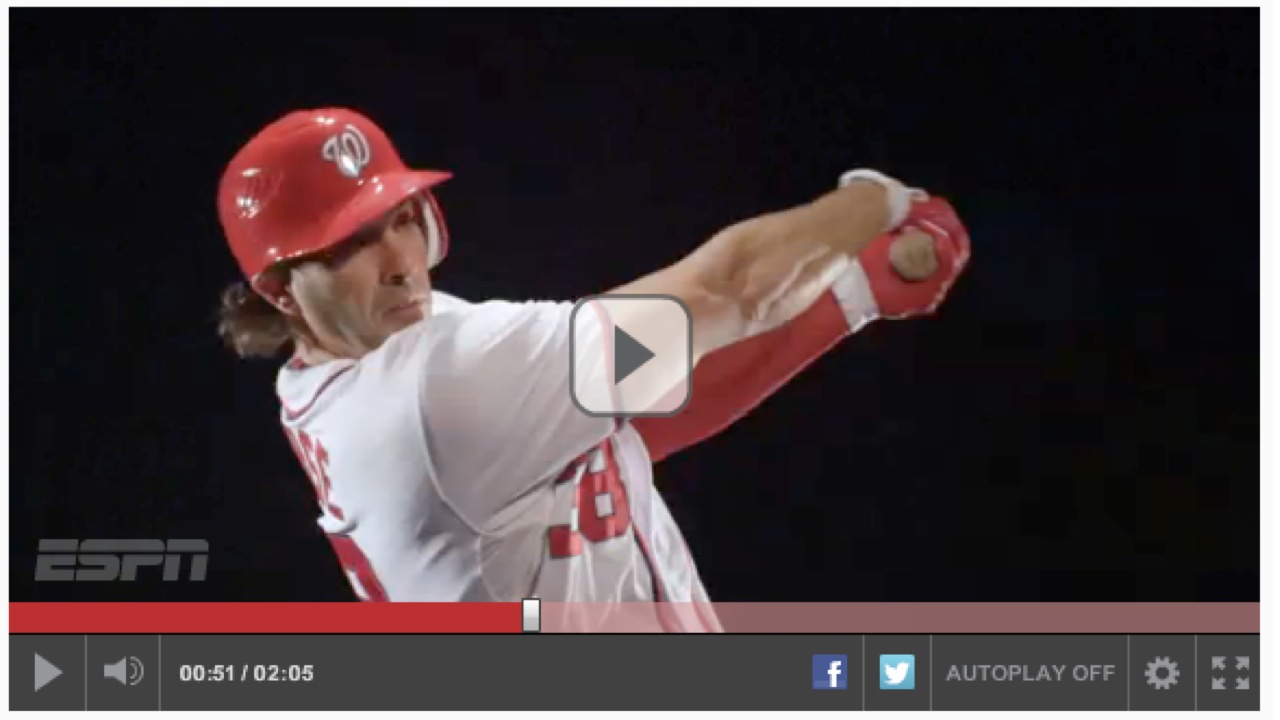GeoSafari Laptop
We were offered a box of books for free from a fellow homeschooling family, which actually turned into two boxes of books—including an old GeoSafari Laptop! My daughter has a modern Vtech laptop that my parents bought her a couple of birthdays ago that she loves to play on, and it features animation, sounds, songs and interactive talking.
Yeah, this GeoSafari doesn’t do any of that.
It’s still pretty rockin’ though, once you figure out how to use the thing. It didn’t have the instructions so I spent a bit of time trying to figure it out. Then I realized that duh, it’s 2013 and I can Google it, so I did, and found the PDF version of the user’s guide. Nice! Don’t you love living in this year? I know we complain a lot about stupid things, but really it’s pretty boss to live when we do.
It was actually pretty easy once you read what each button is for. You just stick each card on top of the machine, then plug in the number of the game plus the number of players, the amount of time you want allocated to answer, and if you want your questions randomly or in order. Then you play by answering questions on the sheets, and if you get them right a high-pitched noise results. Low pitched noises sound when you get a wrong answer. Get them all right and you get the whole thing to light up.
There are tons of cards on this thing, from math and science to language arts and of course history and geography. It’s not just geography, though, so don’t let the name fool you. The cards all fit in the case even though I didn’t think they would—trust a child to figure that one out, which is what my daughter did.
I think the game itself was rather underwhelming for my seven-year-old, though, who is used to complete interaction and guides speaking to her, but it’s actually intended for ages eight and up, so maybe she’ll come to like it someday. In the meantime, her dad and I are having a blast with the thing! I beat the game at landmarks of North America (big feat there) while he only missed one on wonders of the world. We totally bombed the native American artifacts quiz, though, which makes me feel rather dubious about the junior archeologist program I’ve been doing with the kiddo…
The Art of Extreme Self-Care
Cheryl Richardson’s books are often quite alike. Her advice is usually similar in every book that I’ve read of hers, from Take Time for Your Life to Life Makeovers (which was probably my favorite). They all can be helpful if you’ve never read any of her books before or if you are brand new to coaching and self-help, but generally there’s not a whole lot of new concepts. Still, they are enjoyable reads so I bought myself a used copy the other day.
This book will help me achieve one of my goals while 30—to complete a program and pass it on. I have a bunch of programs already, from Julia Cameron books I haven’t opened yet to boxes of breathing techniques and other self-empowerment courses. I am at the point where I don’t think I need any self-help anymore; I’m quite alright as I am. That said, I actually enjoy doing these programs in my journal and learning more about myself, sometimes even becoming a better parent or wife in the process, and that’s why I keep doing them.
The Art of Extreme Self-Care really just reminds me of a lot of Richardson’s other works, and I have to keep the demographic in mind to avoid getting irritated. Much of what she suggests, for example, is for privileged people without full-time jobs and young children. I know many single working moms who could not interview and pick and choose health care providers, for example—not just because they cost lots of time (that many health care providers don’t have, either, by the way) but also because many of these people don’t have health insurance, either. That money’s going to be spent elsewhere, like clothes and shoes for children. The same goes with anything from using a coach or even nurturing a hidden passion when all some of these moms want is a damn nap when they can fit it in.
All of this said, I think some of her ideas, such as the absolute no list that you make of things that you will not say yes to, are good ones that can benefit lots of people. The book is filled with good questions to think about, too, which I really like. It’s things like guided questions that make me see the most changes in my life—and help me to recognize what problems I might be ignoring. I do think a lot of people could benefit from this book, and I plan on passing it along to someone I love once I finish it.
Mindful Monkey, Happy Panda
As we continue our journey toward being more mindful and embracing our emotions in healthy ways rather than pushing them away, my daughter and I are reading many more books about this practice. It’s such a different way of life from most Western families, so at first it feels really foreign—even after practicing meditation together for years! Anger is one thing that our family can regularly do—we just have not necessarily handled it very well, until now.
A lovely book about mindfulness for children is Lauren Alderfer’s Mindful Monkey, Happy Panda. We have previously learned about mindfulness from the panda Stillwater in the books Zen Shorts and Zen Ties by Jon J. Muth, but this book goes a bit farther. Instead of engrossing us in a story—which was wonderful in the Muth books, mind you—Mindful Monkey, Happy Panda actually walks us through the practice of mindfulness, explicitly explaining how to do this every day.
Monkey approaches Panda and asks how the animal is able to stay both happy and calm every day. The book does not use “he” or “she,” but merely Monkey and Panda, which I absolutely love. There’s no gender segregation or implied wisdom from one sex to another, and the book can easily apply to any audience. Panda tells Monkey that being happy and calm come when you live now—not tomorrow or yesterday. Panda eats, sleeps, works, and plays, and though Monkey does these things, too, Monkey thinks about other things while doing them (for example, eating while working). Panda tells monkey that to be happy and calm, you only think about what you are doing right then and there, all of the time, and Monkey loves that so much that Monkey decides to do the same thing right then and there.
My daughter immediately asked if we could buy this book, since I borrowed it via interlibrary loan, and to read it again. I think it was worth the loan just for that! But I also love this approach and it’s simple enough for both kids and adults to learn from it. If our culture was just a bit more mindful, I think it could do us all a lot of good. In the meantime, I’m going to be mindful today by eating only while eating—not while working or reading, as I normally do. You have to start with baby steps!
Jambo Means Hello
It’s really no wonder that Muriel Feelings’s Jambo Means Hello won a Caldecott Honor. This picture book may be in black and white, but don’t let that fool you. It’s just as engaging and interesting as any other picture book if not more so with Tom Feelings’s lively artwork. The Swahili alphabet book teaches so much, from actual pronunciation of Swahili words to the vocabulary itself, as well as the geographic regions where one can expect to encounter the language.
But it’s also so much more than that. There are so many different examples of African culture in this book that I think would really help widen the gaze of so many Americans—both children and adults!—as we seem to loop everyone from Africa together without even thinking about how different people are from different countries. Part of it may be because we are so used to being looped together in 50 separate states of one large country—but I think it’s attributed much more to the fact that we pretty much ignore Africa and the rich culture there.
Did you know that both the guitar and the xylophone either came from Africa or have roots there? I have read elsewhere that early democracies and thriving kingdoms come from Africa as well, so why the heck don’t we hear about this stuff in school? We learn about the Egyptians and that’s pretty much it. Is it a cultural shame that permeates our textbooks and souls, a guilt that makes us turn away from the continent where we kidnapped people for slavery—or a nationalistic strategy to keep us in the dark about the continent for the exact same region? Perhaps it is both, but for whatever reason, I am very interested in learning much more about Africa, and especially in helping my daughter learn more about it, too.
This book is a wonderful place to begin. Written by a teacher who lived in Africa for two years, it has a certain reverence to it that I like. It doesn’t talk down to readers or give brassy “they do it this way!” explanations that many cultural books are inclined to do. Its artwork is beautiful—simple yet emotional, conveying the joy on peoples’ faces as they interact, care for their families, and dance. Its information is just as beautiful, with terms like “heshima,” which means respect for elders. (Why do so many nations honor elders when we dump them into nursing homes?) You can learn about food, customs, beauty, and so much more with this lovely book.
Brighten up at LOFT
Bright spring collections are arriving at LOFT! Receive 30 percent off all full-price merchandise with code SHOP30 when you shop and order online. You'll also receive free shipping on orders of $125 or more. Happy spring shopping!
Pom mindfulness
That sounds really sarcastic, but I am serious here. I am onto something! Unless anyone else has already presented the idea of using pomegranates as a meditative instrument, in which case, I am terribly sorry.
My husband works in the grocery department of a large retail store and since they’ve had pomegranates on sale, we’ve been buying them like crazy. Before this, the only pomegranates we’d ever had were in the form of juice or flavor agents in, say, bubblegum. So it’s been a big treat for us all.
The thing is, I was intimidated about getting the seeds out of the fruit. They’re the only part you can eat, and I had heard it was a complicated process of submerging the fruit in water, draining the water and getting the seeds out, etc. Then I read about a woman who says you can just cut it in quarters, peel it apart, and pick the seeds out—a tedious process, but not impossible.
The first time I did this, it took me an entire episode of Sesame Street. My daughter kept stealing them from the bowl—which was fine; best snack ever!—so my pile never looked as big as I thought it should, but I loved the juice on my fingers. I didn’t love getting the membrane stuck on me, though, and I washed my hands often through the process.
Now when I do it, it only takes me about 20 minutes overall, and I am in love with the process. I know I’m lucky to have 20 minutes to spare at all when many moms don’t, but if you do get the time, I highly recommend cutting a pomegranate and slowly flicking out the seeds with your fingernails if you ever get the chance. It’s a completely different sensory experience that gives you a yummy end result while also providing you with plenty of meditative time. You sit there and do the repetitive motions over again and again, feeling the juice on your fingers, occasionally nibbling on a seed, and before you know it, you are dead calm. It’s absolutely incredible.
Yesterday when I got angry after reading something political, I sat down to peel a pomegranate. Wouldn’t you know that afterward, my anger had completely dissipated and I felt calm—not to mention the fact that I had a big bowl of delicious seeds to eat! If you have a hard time meditating and making your mind still, I really think you ought to give this a try. If nothing else, you get a healthy snack from it.
The Threat of Personal Nukes
One of the biggest security issues that the U.S. has to deal with is asymmetrical warfare. Our focus was on nation state fighting nation state in the last century but in the last few decades we have been dealing with attacks by organizations or lone individuals. This makes responding to attacks more difficult because we don’t necessarily have a readily identifiable foe in a known geographic location to counter attack. We are constantly debating proper ways of dealing with such attacks and one big problem is matching our response to the level of attack. If the attackers are dug in in civilian areas, there is a big problem of collateral damage and the death of bystanders if we use the full power of our military.
Evolution of weaponry has also aggravated the problem. With the development of every more powerful weapons we are now at a point where a single person can bring down a passenger plane or blow up a building. High capacity magazines in assault rifles allow individuals to kill dozens of people in minutes. Chemical weapons deployed by individuals could threaten thousands and biological weapons could threaten millions.
Perhaps the most serious scenario is one in which a single individual obtains and detonates a nuclear bomb. I have spent a lot of time in this blog discussing big nuclear bombs and intercontinental missiles. However, a lot of research and development has been done on tactical nuclear weapons in the kiloton range that could be deployed by small teams or even single soldiers on a battle field. A series of small nuclear missiles as well as nuclear mortar shells have been designed and, in cases built.
Some work has been done on what have been called suitcase nukes. This would be a nuclear bomb small enough for one person to carry. The U.S. and Soviet Union develop nuclear bombs that one person could carry in a special backpack. There are reports that Israel has created nuclear bombs that could fit into a suitcase. This type of nuclear weapon has been popular in movies, television and novels because it would be so difficult if not impossible to defend against. What we have is the prospect that one person could bring such a bomb into a densely populated area and kill hundreds of thousands of people. This is scenario is perhaps the culmination of asymmetrical warfare.
I have never been a fan of Supreme Court Justice Anton Scalia. Although touted as a brilliant legal scholar by the Bush administration, I find his grasp of the Constitution weak, his legal reasoning confused and his recall of history often mistaken. On the bench and in his written opinions he is arrogant, sarcastic, and vicious against those who disagree with him. The reason that I mention Scalia is that in a recent discussion of the Second Amendment right to bear arms, he said that obviously it was referring to personal weapons and did not extend to such things as cannons, mortars and artillery pieces. Then he said, on the other hand, there are shoulder fired rocket launchers that could bring down planes. They did fall into the category of personal weapons and would have to considered and debated. Not sure if he was serious or just thinking out loud. However, in the current debate over the Second Amendment, some of the extremists admit that they want to own enough power weapons and ammunition to take on the U.S. Federal government. I am afraid that some of them would love to get their hands on a suitcase nuke.
(BTW, I feature suitcase nukes in the novel that I am currently writing – Tripod of Saints.)
Container to carry the U.S. Mk-54 Special Atomic Demolition Munition:
Michael Morse as Swing Virtuoso
.
HERE IS THE ESPN VIDEO, a 2:05 clip in which Michael Morse explains the dynamics of his hitting motion.
.
I was in a terrible slump in the late 1970's. The harder I tried, the worse I got. Finally I was walking the course one day and a fellow pro, seeing the look on my face, asked me "Johnny, do you LIKE golf?" After that I never had a bad slump again. - Johnny Miller, ancient SI interview, reproduced from memory
.
BSR linked us up to the ESPN vid ... we ought to embed that puppy in the sidebar. A picture's worth 1,000 words. :: wait :: OK, it's embedded. Go check out the 2-minute video; you'll come back excited for the 2013 season.
Amigos scheduled an 9:45 a.m. appointment for Morse's swing. Dr's R/X: take a two-year contract extension and call him in the morning. All this and brains, too, eh Michael.
Morse's comments in boldface, with our cornball kibitz following on that:
.
"The perfect swing for me is ..." It's not an offhand phrase that he tosses out there one time. The interview is saturated with Morse's search for better and better swing dynamics.
His enthusiasm, his love for his craft, is contagious. Remember Bruce Lee? "This is not about winning. It's about perfection."
In aikido this is the mu-shin, the "no-mind," where you are not distracted by GREED FOR SUCCESS. Consider that phrase, GREED FOR SUCCESS, for a few minutes today.
With mu-shin, with TRUE focus on the perfect process, you are in flow. You are focused on slightly better and better execution, and you gain a state-of-mind that transcends the enemy and the danger.
Compare a basketball shooter who has the hop in his step, the flick and followthru in his fingertips, who is seeing the swish of the net go cleaner and cleaner, who is enjoying the purity of the basketball's rotation, and whose opponents sort of vanish into transluscence around him.
Schwarzenegger said that, doing dumbbell curls, he became mesmerized by the visual of a ridiculously huge bicep, overpowering the dumbbell, getting larger and larger ... "Every rep, every set, is one step closer to your goal. Even if a bomb went off next to you, you would not notice it."
.
"It starts with my base ... it's like COILING like a SNAKE." There is a reason that shao lin monks compare kung fu movements to animals'. An animal, obviously, has a very pure and sincere motion as it attacks.
There is a reason that Jesus compared very complex thought processes to very simple analogues - His parables were always grounded in everyday things like the flowers of the meadow, the grape on the vine, the door into a barn, the wind blowing through the field. There is something about the "everyday item" parable that is unsurpassable when it comes to absorbing difficult information.
Morse isn't musing as he describes the snake, isn't grasping for a metaphor. The snake coil is a mantra for him, a dynamic visual that he reproduces, AB after AB, without effort. In fact he rehearses this coil before AB's.
We're not saying that Morse has spiralled off into his own MLB hitting universe. We're saying that he is evidently in the Ted Williams, Ichiro, Wade Boggs category of player, the one who enjoys the beauty and virtuosity of hitting for its own sake.
Morse's obvious joy in the game is a major competitive advantage for him. Happy-happy joy-joy thoughts are helpful because --- > they promote the visualization of home runs, rather than of strikeouts. It's helpful for a batter to not be thinking about striking out during an AB.
.
"I call it my samurai cobra snake." Watch the video and you will see all of Morse's appendages contract in to one particular place on his body ... the CG. The hara. The one point. His movements are then organized correctly, and derive their power from the right spot.
Notice, for example, that Morse's hands in "the cobra" are near his CG, like where you have them when you're opening a jar of pickles.
.
"My front leg is real light on the ground, and my hands give me a nice whip feeling." These are wispy, effortless characterizations that carry a HATHA YOGA flavor. Google Jennifer Kostel Yoga and you'll hear her talking like this. It goes to the question of body control, of being better-than-average at moving your own body parts.
.
"The biggest thing I wanna feel is ... my body ... like a DOOR HINGE. ... I want everything to just ROTATE." Bee-yoo-tee-ful. The thing here is that it captures a very difficult movement --- > in a very decisive and convincing parable.
Words on paper are fine. But some mantras WORK and some don't.
The hinge on a fire door is not flexible about the way it's going to move - it does not move one way in the morning, and another way in the evening. Its direction of movement is a given, and other things are welcome to coexist with the hinge after they have accepted the nature of the hinge.
.
"My hands are freed up ... :: clears biceps over pecs several times :: ... I feel like I can go inside and get a ball... I can go right over the middle ... if it's outside, I'm right there." - Reminds of Bruce Lee's loose-as-a-goose ready state just before an exchange of blows occurred..
Obviously, other MLB hitters understand swing dynamics, also. However, other MLB power hitters do not have Mike Morse's results:
Morse is considerably better than other ML cleanup hitters, when it comes to strike zone coverage.
.
"My ENERGY generates from my legs, goes through my core, gets to my upper body" - there's a reason that in aikido, we speak in terms of energy. It promotes the mental "capture" of long, dynamic lines of interplay, captures the idea of acceleration, and gives a 3-D perception of the acction.
A beginner might speak in terms of blocking a punch at the 6-inch mark in front of his face. A black belt might think in terms of a 3-foot-long lightning bolt, with a vector and a launch moment, and it's easier to avoid a long, moving line than it is to avoid a suddenly-appearing dot.
.
Top hand rotation and "Topspin" swing - look at the positions of Morse's palm in the below screen captures:
Morse has a miniscule 6% infield popup rate for his career. Further, that 6% is with respect to his fly balls -- and his fly ball rate is ITSELF much lower than average. Here's the dreaded Ibanez/Sexson "topspin" hitter, a guy with a high grounder rate and yet a high HR rate.
You want to know why Morse has a sensational .344 BABIP for his career? Part of it is that he pops up like twice a year. :- ) Another part is that he hits the ball a little harder than, say, Brendan Ryan does. Another part of it is that grounders, whizzing through the infield with topspin, "accelerate" with respect to grounders that don't have as much topspin. In the same sense that Stephen Pryor's fastball rises, Mike Morse's grounders accelerate.
Morse is a career .295 hitter, despite 120+ strikeouts a year and an 0.25 EYE. Despite the fact that Morse is one of the strongest players in baseball, you can afford to think of him as a .300 hitter -- he gets on top of the ball, he uses the whole field, and he whistles the ball through the fielders.
................
Kendrys Morales is similar - a guy who would be a good hitter (HIT tool) even if he didn't have power. Despite their sizes, Morse and Morales are two of the best hitters among power guys in the majors.
Even for the Angels, even last year, when Morales was in the lineup he usually hit #4 for them. In 2009 and 2010, he most often hit #5.
Morse last year split time between the #4 and #5 slots; in 2011 he usually hit #4 for the Nationals. Zduriencik has added two guys who have been hitting cleanup --- > for contenders.
Mike Morse and Kendrys Morales are not superstars, not by a long shot, but they are the first legitimate difference-making bats we've had in Seattle since the guys playing for the 116-win club.* With the exception of Richie Sexson for a year or two, they're the first thumpers in Seattle since the 2001-03 Edgar era.
I sure wish people would reflect on these guys' roles as offense fixers, guys who disrupt enemy pitching, rather than trying to cleverly school-essay them as 2-WAR mediocrities. These two guys can flat out hit, and it's been awhile, gentlemen.
.
John Jaso Can Probably Hit Lefties
.
=== Overexposure, Dept. ===
Seen at BJOL:
About platoon splits. The one player that I remember having a reverse platoon split and a long career was Brett Butler. I looked him up and I am partially correct. His OBP v righties was .374, v. lefties .384. He slugged better the right way. (OK, Brett could never really be said to slug but you get my drift.)Asked by: Steve NAnswered: 1/18/2013I do. Butler would be the prototype of a player with a low platoon split. Since there is no platoon differential on balls in play, the platoon split is proportional to strikeouts, walks and homers. The less of those things a player does, the smaller his platoon differential.
.
:: DINGGG :: and it goes off in your head, how many Kenny Loftons or Luis Polonias or Placido Polancos have ever needed to be platooned?
.
=== Qwibbles and Bits, Dept. ===
OK, we start with the realization that Three True Outcomes players -- Jack Cust, Russell Branyan -- are going to be more susceptible to platoon issues. Right off the bat, we know why a guy like Mark Reynolds is so up-and-down. He's fighting a RH-on-RH war with tons of deep counts.
But we'd say that some guys have a wider EYE split, LH vs RH. John Jaso, for example, maintains an EYE near 1.0 against LHP's. So platoon differential is in proportion to TTO tendencies, but it also skews depending on K/BB skill against "tough" LH-on-LH pitching.
Qwibble #2, there could easily be some platoon differential on balls in play -- I'll guarantee you that some players' flyball ratios go up on the "bad" platoon split, and this will affect BABIP a little. But we know what Bill means here, and the qwibble should not diminish the value of the insight.
This will be something that I'll watch carefully in the future: a player's EYE split, LH vs RH. And it will give me a huge advantage in assessing true talent level.
:: winning Anthony Hopkins smile ::
.
=== TTO/Platoon Theory As Applied to John Jaso ===
Jaso's EYE was great for his career against LHP's, super great. He's got a 117:100 EYE against righties, actually above 1.0; he's counting cards and beating the house. But he's also 23:28 against lefties, wow.
At this point you'd think, huh, if Jaso is really a poor hitter against lefties, I guess it's pretty much in the fact that his homers disappear.
And the homers, lifetime in the majors, are .... 19 HR in 900 PA against righties, and only 1 homer his whole life! against lefties. A-haaa!
Not so fast. Jaso has 1 homer in 150 PA's against lefties: if that had been 3 homers, his ratio would be exactly the same against LH's.
I think Matthew, at LL, demonstrated that in the minors, Jaso had perfectly normal (? correct me if I remember wrong) platoon splits. Contrary to popular opinion, this data is important.
At this point, if you were betting against Jaso hitting LHP's going forward, you'd feel awfully queasy about the money you'd laid down.
.
=== The Scouting Eye ===
Jaso has a very level swing, Keeps the Bat In the Zone a Long Time (KBIZLT), reads the pitch and lashes with a quick bat, and there isn't any apparent reason TO ME that he shouldn't be able to hit lefties. I mean, if any lefty hitter could (short of freaks like Griffey, Hamilton, etc) John Jaso would be exactly the kind of guy who could hit LHP's.
I can't see him hitting homers against lefties, or driving the ball with much authority. I'll bet you agree.
But therein lies the real concern...
.
=== Daric Barton Casey Kotchman Disease ===
In 2010, the lefty Barton led the American League in walks at the age of 24. He hit .273, this being in Oakland, and his OBP of .393 left his OPS+ at 120, despite lack of power.
There ain't any such thing as a player with a .400 OBP who can't play for Dr. D's team. And had Jack Zduriencik traded Daric Barton, following the 2010 season, you can only imagine the blog reaction. :: SHUDDER ::
Here's the thing, though. Daric Barton cannot drive the ball with authority.
.
.
.
.
.
.
.
You can examine the followup to 2010 for yourself, with special emphasis on the question of "Can this player maintain his best offensive production despite full 550-AB exposure over the long term?" Barton's moment of glory lasted for how long, exactly?
I mean, if Jaso's giving you that tough a time at the plate, pitcher, it's 3-and-2 and he's fouled four pitches off, just throw a strike. What's going to happen? Do you believe in BABIP theory or don't you?
.
Edit to add, we withdraw the Barton example, Your Honor. The good denizens of SSI politely noted that Dr. D was feebleminded to disregard Barton's shoulder injury. In the comments below we substitute a good selection of high-OBP, low-SLG one hit wonders who faced doom. Including but not limited to Casey Kotchman, Reggie Willits, Jose Vidro, our own Chone Figgins, and fill out your own scorecard.
.
=== Dr's Prognosis ===
We don't say that John Jaso is a dead man walking. If he's not overexposed, he'll probably do a scrappy job with the bat for several years. And there's the possibility that his plate skills are SO diamond-hard that he'll become Joe Mauer Lite, or something.
Over the period 2010-12, there is one (1) fulltime player who has maintained a high OBP -- over .370 -- despite not having power. That player is Mauer. As a GM this would be my question about Jaso: sustaining OBP in the absence of power.
.............
There's one other fulltime player who's maintained a fairly impressive OBP despite lack of power, that being Brett Gardner. But now we're kind of into Leadoff Hitter territory, a guy whose OBP is partly due to his legs. Still, you could possibly imagine Jaso producing a .360, .370 OBP hard on the barrelhead, despite lack of power.
Nick Markakis Lite is one other suggestion, as a model for Jaso to shoot at going forward.
If you're bullish about Jaso's ability to emerge as a minor star in the American League, then you're bullish about his ability to pop the ball for about 25 doubles and 15 homers per year. He did that in 2012.
I don't see it, given the (lack of) physical torque he seems to apply, but if you do see positive gap power for Jaso, that's reasonable. And a .450'ish SLG would definitely unlock the door to his big-money future, because his OBP is definitely going to be real high in that event.
................
Zduriencik didn't see Jaso as a role player because Jaso can't hit lefties. He saw Jaso as a role player because he's been a slap hitter* who has, in a very limited amount of time, looked better than he probably actually is.
I'd like to have Jaso on my ballclub. As a 300-AB guy, and a backup catcher, he is a championship #10-11 hitter. It was painful to give him up; I hated to do it. I'd rather give him up than give up any of the Big Three, however.
.
BABVA,
Dr D
..........
*Jaso's power index is about 90-100. He's not a singles hitter, exactly, but his level of gap power isn't going to chase pitchers off the strike zone.













